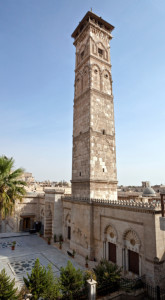
The fighting in the Middle East has torn the region apart, and countless people have died. Many who remain face the constant threat of persecution and live under unimaginable conditions without access to adequate food, housing and medical care. Another consequence of the conflict has been the destruction of a number of important and irreplaceable Middle Eastern monuments.
Syria
- Minaret of the Great Mosque of Aleppo
The Great Mosque of Aleppo is believed to be one of the oldest structures of its kind in the world. It was originally built at the start of the 8th century. In 1090, its famed minaret was added. Minarets are tall, distinctive spires used for the Islamic call to prayer and common architectural features of mosques. The mosque is believed to house the remains of John the Baptist’s Father, Zechariah, and was badly damaged in fighting in October of 2012. In April of the following year, the minaret was completely destroyed. Some reports attribute the destruction to tank fire, and others cite explosives as the cause.
- Khalid ibn al-Walid Mosque
The Khalid ibn al-Walid Mosque is named in honor of an Arab military commander who was victorious in an important 7th century battle and is buried on the grounds. Designed and constructed in the Ottoman style, the Syrian government claimed it was being used as an “arms and ammunition depot” by the rebel forces in 2013. It sustained heavy shelling by government troops and was severely damaged, including the interior of Khalid’s tomb. Several years earlier, the mosque had been featured on sets of stamps.
Iraq
- Jonah’s Tomb
Jonah was an important biblical prophet who was, according to the Bible, swallowed by a whale and lived inside his belly for three days and three nights. God then commanded the whale to spit him out. His tomb, located in Mosul, was believed to have been constructed in the 8th century B.C. and thought to have contained his remains and a tooth from the whale. The site was sacred to both Christians and Muslims. ISIS militants destroyed it in 2014.
- Minaret of the Great Mosque of Samarra
Completed in 851 A.D., the Great Mosque of Samarra is located approximately 2 hours north of Baghdad. The site’s cone-shaped minaret, the Malwiya Tower, was particularly distinctive. It was made of sandstone and had spiral ramps worshippers would climb. It stood 162 feet high. In 2005, the top was blown off by insurgents.
- Mosul Museum
In Iraq, the Mosul Museum is second only to the National Museum of Baghdad in size. ISIS destroyed its stone sculptures and other ancient artifacts in February of 2015. The militants proclaimed the statues were contradictory to the beliefs of Islam. The destruction at the museum occurred one day after books from Mosul libraries were burned.
- Nimrud
From 1250 – 650 B.C., the ancient city of Nimrud was one of the most important in the Kingdom of Assyria. Modern Nimrud contained many priceless statues and excavated ruins. In March, ISIS used bulldozers and explosives to destroy numerous buildings. A large number of statues were demolished with sledgehammers.
Afghanistan
- The Buddhas of Bamiyan
The Buddhas of Bamiyan dated back to the 6th century. They were two huge statues carved into sandstone cliffs approximately 140 miles northwest of Kabul. Even more remarkable, the statues were constructed at 8,200 feet above sea level. The Taliban destroyed them in 2001 because they believed them to be idols. Several countries have committed to help rebuild them.
Gaza
- Al-Omari Mosque
In 2015, the Al-Omari Mosque was destroyed by Israeli airstrikes. It was located in Gaza and was centuries old.
Many experts feel the destruction of these eight sites is a cultural catastrophe. Unfortunately, there are more on the list, and no end in sight to the conflict in the Middle East.

